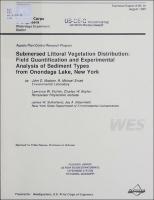Please use this identifier to cite or link to this item:
https://hdl.handle.net/11681/6404| Title: | Submersed littoral vegetation distribution : field quantification and experimental analysis of sediment types from Onondaga Lake, New York |
| Authors: | Madsen, John Douglas Smart, R. Michael Eichler, Lawrence W. Boylen, Charles W. Sutherland, James W. Bloomfield, Jay A. |
| Keywords: | Aquatic plants Littoral zone Macrophytes Sediment Revegetation Lake restoration Onondaga Lake (N.Y.) Aquatic Plant Control Research Program (U.S.) |
| Publisher: | U.S. Army Engineer Waterways Experiment Station |
| Series/Report no.: | Technical Report (Aquatic Plant Control Research Program (U.S.)) ; no.Technical Report A-93-14 |
| Abstract: | Onondaga Lake, located in upstate New York near Syracuse, has been heavily impacted by industrial and domestic effluent. Due to these impacts, the native littoral vegetation had largely disappeared. The primary purpose of this research is to revegetate the littoral zone of the lake. In order to achieve this goal, field and greenhouse studies were performed to evaluate factors limiting the growth of aquatic plants. Species selected for greenhouse studies included sago pond weed, Eurasian watermilfoil, water celery, elodea, curly-leaf pond weed, waterchestnut, American pond weed, white water-lily, cattail, arrowhead, and rigid-leaf arrowhead. Only 13 percent of 3,497 quadrats examined in the lake had aquatic plants. The most common plant was sago pondweed (Potamogeton pectinatus, 11 percent); water stargrass (Heteranthera dubia, 2 percent), curly-leaf pondweed (Potamogeton crispus, 0.3 percent), coontail (Ceratophyllum demersum, 0.3 percent), and Eurasian watermilfoil (Myriophyllum spicatum, 0.06 percent) were also found. Growth of sago pondweed on Onondaga Lake sediments was correlated to the abundance of plants in situ, indicating that growth limitation of plants in the lake was partially due to sediment-based nutrition. Growlh on Onondaga Lake sediments was substantially below the reference sediment. Tests of different species indicated several plants could be used to revegetate Onondaga Lake littoral zones, depending on the sediment type. Sago pondweed (P. pectinatus), American pondweed (P. nodosus), and arrowhead (S. latifolia) were the three most successful and desirable plants for revegetation efforts. |
| Description: | Technical Report |
| Gov't Doc #: | Technical Report A-93-14 |
| Rights: | Approved for public release; distribution is unlimited |
| URI: | http://hdl.handle.net/11681/6404 |
| Appears in Collections: | Technical Report |
Files in This Item:
| File | Description | Size | Format | |
|---|---|---|---|---|
| TR-A-93-14.pdf | Technical Report A-93-14 | 10.68 MB | Adobe PDF |  View/Open |